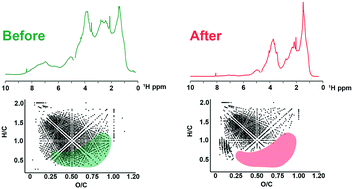Molecular level characterisation of ion-exchange water treatment coupled to ceramic membrane filtration†
Abstract
FT-ICR MS, NMR and ATR-FTIR were used to gain insight into the dissolved organic matter (DOM) removal process throughout a pilot water treatment system. The pilot plant under study utilises suspended ion exchange (SIX) followed by in-line coagulation with (ILCA) polyaluminium chloride and ceramic membrane filtration (CMF). MS results indicate that the SIX treatment is removing DOM irrespective of the compound type (>90% formulae similarity between SIX treated and raw water). However, the ILCA–CMF treatment substantially altered the chemical composition of the DOM by removing a high proportion of the aromatic and phenolic compounds. This was also confirmed by NMR and ATR-FTIR. An adjoining WTW plant which uses the same coagulant as the pilot plant, flocculation mixers for inline flocculation and filtration via MEMCOR® hydrophilic membranes did not show any selectivity when processing the same inlet water. Removal of aromatics/polyphenols in the pilot plant can therefore be attributed to the CMF step. Removal of aromatic/phenolic compounds is important, as these are known to react more readily with chlorine, potentially producing trihalomethanes – substances regulated in potable water.



 Please wait while we load your content...
Please wait while we load your content...